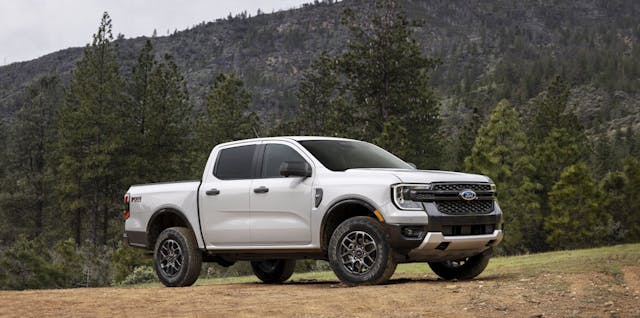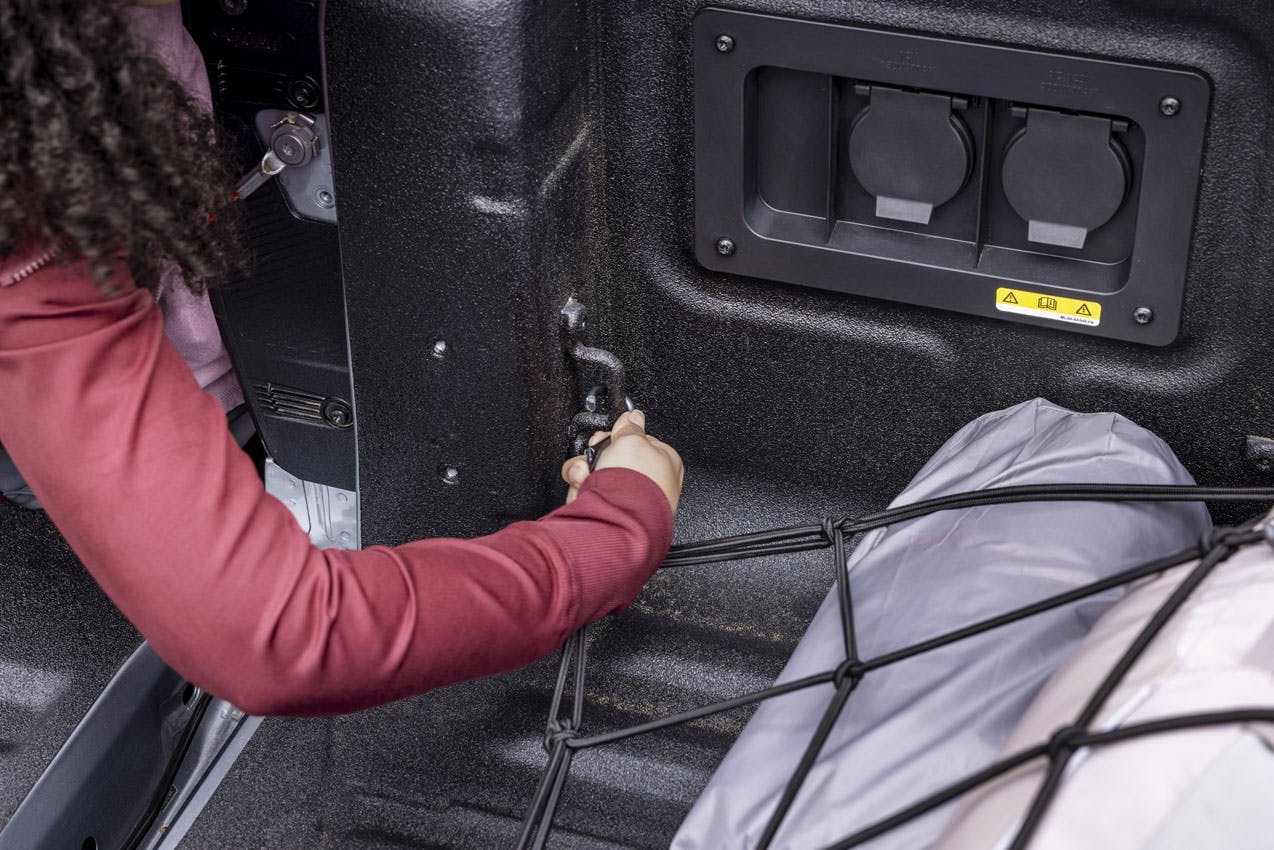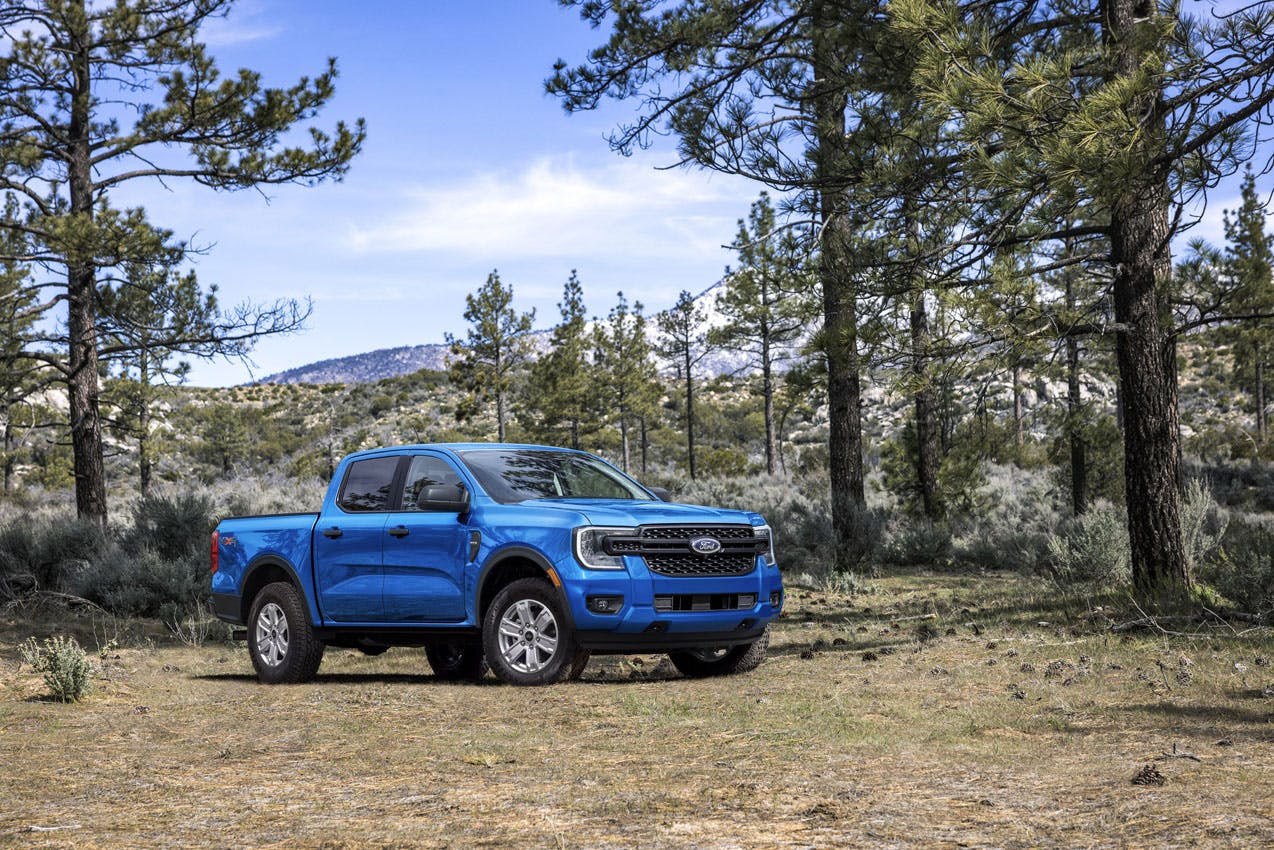Media | Articles
2024 Ranger: Ford’s midsize pickup matures, adds V-6
When you read about the “truck wars” on these pages, we’re usually referring to full-size pickups. But the midsize-truck segment, occupied by the same companies, may be the site of the fiercest fighting.
Ford just announced the 2024 Ranger pickup, a thoroughly reworked midsizer that boasts a raft of changes including new styling, two new engines, and some significant engineering changes.
Ford calls the 2024 Ranger an “all-new” pickup, which is … generally true, depending on where you draw the line. In support of that claim: Bold new styling, a reengineered rear suspension, two additional engines, and a thoroughly revamped interior. In contempt of that claim: Technically, this one still rides on the T6 platform. However, the 2024 model does use a new version of said system, which Ford refers to as the T6.2. (The T6.2-based Ranger has been available in other markets outside the U.S. since 2021.) Might seem like splitting hairs, but context is important.

A new, hydroformed front structure enabled engineers to move the front axle forward a touch, which gave them space for one of the biggest updates to the 2024 Ranger: the addition of Ford’s 2.7-liter EcoBoost twin-turbo V-6, that offers 315 hp and 400 lb-ft of torque. The base offering remains the 2.3-liter, turbocharged four-cylinder good for 270 hp and 310 lb-ft.
(There’s also a 3.0-liter version of that twin-turbo V-6, but it’s exclusive to the Ranger Raptor. Learn more about that 405-hp, 430 lb-ft engine by checking out our Ranger Raptor deep-dive here.)
Marketplace
Buy and sell classics with confidence
That engine lineup might sound familiar. The Bronco, which also rides on the T6.2 platform, also offers each of those engines, albeit with slightly different power figures. While you can get a seven-speed manual transmission in the Bronco, the sole gearbox offered in the 2024 Ranger is Ford’s 10-speed automatic transmission.
An electronic shift-on-the-fly 4×4 system is available as well, as is a locking rear differential if you opt for either the FX4 (4×4) or FX2 (4×2) off-road packages.

As with the outgoing Ranger, this one rides on a fully boxed steel frame. The wheelbase and track width have been stretched two inches apiece relative to the outgoing Ranger, up now to 128.7 inches and 63.8 inches, respectively. That added wheelbase doesn’t stretch the new Ranger, however; it’s 0.2 inches shorter than the one it replaces.

The rear suspension has been heavily reworked, with the shock mounts moving outboard of the frame rails. The Ranger still utilizes an independent suspension design up front and a solid-axle rear design with leaf springs, the norm for this segment. (Only Jeep’s Gladiator features stick axles at both ends.)

With regards to “truck stuff,” the 2024 Ranger acquits itself nicely. Max towing capability is 7500 pounds—same as the outgoing model, and max payload capacity rings in at 1805 pounds—up 151 pounds over its predecessor. Max towing is achievable with any engine/driveline combination, not just the two-wheel-drive version of a truck equipped with the torquiest engine.
That’s great on paper, but a bit odd in practice when you consider that the added grunt (110 lb-ft, to be exact) from the V-6 doesn’t get you any more trailering capability. Ford told us that, according to research it did with customers, 7500 pounds was “the right maximum towing capacity for Ranger customers.” We’ll let you be the judge.
That payload figure is only available on Rangers equipped with a 2.3-liter engine and two-wheel-drive, but other drivetrain layouts are still stout: 4×4-equipped 2.3-liter Rangers can carry 1711 pounds, while 2.7-liter Rangers can still haul 1542. Chevy’s Colorado can tow 200 pounds more than the stoutest Ranger, but the Ford takes the payload title.

A new side-step integrated into the Ranger’s lower truck bed is wide enough to accomodate both feet and can support up to 300 pounds. Thanks to those two inches of additional width, the Ranger’s bed can now squeeze 4-foot sheets of plywood or sheetrock between the wheel wells, something that used to only be possible on full-size pickups. That bed now also offers a 400-watt power inverter to provide juice to your tailgating TVs, off-grid fridges, or corded power tools.
Like the Colorado, the Ranger will be offered exclusively with a crew cab (Ford calls it SuperCrew) and a shorter, 5-foot bed. That’s a departure from the outgoing model, which did offer a smaller cab in conjunction with a larger six-foot bed. That means Nissan’s Frontier is now your lone choice if you’re looking for a smaller cab or a larger bed right now, although the forthcoming Tacoma might retain that configuration flexibility as well.
Ford will offer the Ranger in XL, XLT, Lariat, and Raptor trim levels. Trim-specific touches, like added chrome flourishes available on the Lariat or blacked-out details on the XLT, will help differentiate them visually.

The 2024 model’s cabin features a much more cohesive, thoughtful layout relative to that of the outgoing Ranger. An 8-inch digital instrument cluster is standard on XL and XLT trims, while Lariat and Ranger Raptor will get a full-width, 12.4-inch version. In the center stack, a 10.1-inch screen is standard on XL and XLT, and a 12-inch center screen will be optional on XLT and standard on Lariat. Both the 10.1- and 12-inch screens will run the latest version of Ford’s SYNC 4A infotainment software, which offers over-the-air updates to improve the user experience on the go.
Blessedly, physical buttons and knobs for commonly accessed features like climate control and volume are standard. Relative to those in outgoing Ranger, they’re much better laid out and easier to access.
There’s also a new E-shifter lever, which replaces the mechanical connection between the shifter and the transmission with an electronic actuator. The new shifter is much smaller than the mechanical one that’s still offered in lower-spec Rangers, but the big plus here is that it enables the Ranger to automatically parallel park itself using Ford’s Active Park Assist 2.0 software. It also makes reversing with a trailer attached much easier, as was first seen on the fourteenth-generation F-150.

Ford will build the North American–market Ranger at the Michigan Assembly Plant in Wayne, Michigan. Order books will open later this month, and the first of the 2024 Rangers will reach dealer lots sometime in late summer. If you want the 2.7-liter-equipped Ranger, you’ll have to wait until late fall. Pricing for the 2024 Ranger will begin at $35,755, including a $1595 destination fee, and climb from there.
The new Ranger arrives not a moment too soon. Chevy’s next-gen 2023 Colorado is already in showrooms, and the next generation of the Toyota Tacoma—the best-selling midsize pickup for nearly two decades running—is set to bow on May 19. Ford’s contender needed to bring some serious improvements to this battlefield, and it looks to have done just that. Let the next round of the midsize truck wars commence!
***
Check out the Hagerty Media homepage so you don’t miss a single story, or better yet, bookmark it. To get our best stories delivered right to your inbox, subscribe to our newsletters.











































































Being able to fit 4′ wide things between the wheel wells is key, as I think the only other midsize truck which can do this is the Ridgeline. The inability to fit 4′ wide things flat on the floor of the bed is the one thing I dislike about my Colorado’s bed. I don’t haul such sized things that often, maybe once every two months or so, but when I do it requires inconvenient positioning and uses up a lot more bed space that it should need to.
Many will lament the crew only body but it is pure economics as the profits are limited on these models. They are expensive to build and limited on the price they can charge.
I am not thrilled with the interior and the fact they have to reinforce the frame for a Raptor. The GM frame rolls pretty much the same on all and is very stiff.
This may be a Raptor vs Bison challenge. So far the Bison looks like it will be the rock climber the Raptor the dirt runner.
As for Toyota eh they had better fix the seating and get better power and anti rust properties.